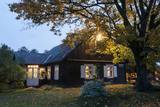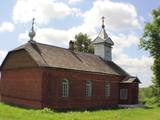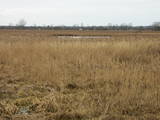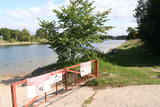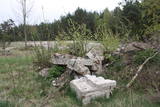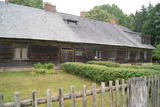| Nr | Nosaukums | Apraksts |
|---|---|---|
|
Kafejnīca atrodas Pāvilostas vēsturiskajā daļā pie Pāvilostas pelēkās kāpas un 0,3 km attālumā no jūras. Modernā stilā projektētās ēkas būvniecībā izmantoti Liepājas Karostas ķieģeļi. Plaši logi, vasaras terase. Sadarbojas ar Latvijas mājražotājiem. Latviešu virtuve: marinēta siļķe, zivju zupa uz ugunskura, aukstā zupa, dārzeņu zupa, ceptas butes un mencas, kūpināti asari un vimbas, plānās pankūkas. Īpašais ēdiens: Cepta āte. |
||
|
Atrodas Mazirbes centrā iepretim Lībiešu Tautas namam, 600m attālumā no Dižjūras. Saimnieki nāk no senas lībiešu – Taizeļu dzimtas, par ko zināmi interesanti nostāsti. Arī pašas mājas saimnieku īpašumā ir jau vairāku paaudžu garumā. Ikviens te apskatāmais priekšmets ir ar savu stāstu un vietējo izcelsmi - pārdzīvojis karus, deportāciju un okupāciju laikus, bet mūsdienās cītīgi un ar mīlestību atjaunots. Saimnieki piedāvā latviešu un lībiešu tradicionālo ēdienu degustāciju ar papildinājumu mūsdienu stilā. Ēdienu sastāvdaļas ir izaudzētas vai ievāktas tuvākajā apvidū, vai iegādātas sadarbībā ar vietējiem lauksaimniekiem, zvejniekiem un ar citiem tradicionālo vietējo produktu gatavotājiem, tai skaitā bioloģiskajiem lauksaimniekiem. Sadzīves priekšmetu kolekciju var apskatīt saimnieku pavadībā. |
||
|
Atpūtas vieta Braslas upes krastā, kurā pieejamas telts un kemperu vietas. Tiek piedāvātas dažādas izklaides iespējas: laivu noma, meža futbols un meža biljards. Piedāvājumā arī grila noma un malka ugunskuram. Sadarbībā ar kafejnīcu "Zem ozola" tiek nodrošināta ēdināšana, iepriekš par to vienojoties. |
||
|
Brīvdienu māja "Rūķīši" atrodas ainaviskā vietā pie Rugāju ūdenskrātuves. Saimnieks audzē un pārstrādā zivis. Klāj galdus, kuros ir latgaļu ēdieni. Sadarbojas ar zemniekiem un zvejniekiem. Latviešu virtuve: Kūpinātas zivis (karpa, Peipusa vēdzele, līnis, sams, breksis). Brekšu konservi. No karpas, līņa un brekša vāra zivju zupu. Putraimu biezputra ar kūpinātu gaļu, pašcepta rudzu maize, uz vietas gatavoti sieri. Īpašais ēdiens: gulašzupa no līņa. |
||
|
Borisovas vecticībnieku kopienas lūgšanu nams uzcelts laika
posmā no 1911. līdz 1921. gadam. Atšķirībā no citiem lūgšanu
namiem apkaimē Borisovas dievnams ir veidots no ķieģeļiem un atrodas kalna pakājē. Zvans šim dievnamam speciāli tika pasūtīts Pēterburgā, un tas izceļas ar savu īpaši maigo skanējumu.
|
||
|
Lieguma lielāko daļu aizņem sekla un aizaugusi ūdenskrātuve, kurā ligzdo daudzas, t.sk. retas un aizsargājamas putnu sugas. Novērtēts, ka lieguma regulāri ligzdo 150 – 450 lielo ķīru pāri.
|
||
|
Atpūtas vieta Gaujas upes kreisajā krastā, pusceļā starp Virešiem un Aņņu tiltu (Gaujiena-Valka; P23). Pieejams galds maltītēm, ugunskura vieta, sausa malka, telšu vietas, tualete. |
||
|
Getliņu ekoloģiskais poligons ir Latvijā unikāls piemērs ekoloģiski saderīgu darbības virzienu ieviešanai. Tā energobloka saražotais siltums tiek izmantots siltumnīcu apsildei, kas nodrošina ideālu vidi lauksaimnieciskai ražošanai (puķes un tomāti - lielaugļu tomāti, tumšsarkanie tomāti, aveņkrāsas ķekartomāti) gada aukstajos mēnešos. Poligona teritoriju (zālāju) nogana ar aitu ganāmpulka palīdzību. |
||
|
Liepājas Karostas kanāls ar tajā izvietoto Padomju armijas jūras kara flotes bāzi un zemūdeņu bāzi veidots pēc Krievijas cara pavēles vēl pirms Pirmā pasaules kara. Bijusī zemūdeņu osta šobrīd ir slēgta teritorija un tiek izmantota saimnieciskām vajadzībām. Karostas kanāls labi pārskatāms no Pulvera ielas puses un nu jau atjaunotā Kalpaka tilta. Starp citu, kur palika unikālais militārais mantojums - padomju laika zemūdenes? Tas ir atsevišķa stāsta vērts. Lieki piebilst, ka igauņiem - vienīgajiem Baltijas valstīs saglabātā zemūdenē (Lembit) ir izveidots unikāls muzejs...
|
||
|
Zemnieku saimniecība „Vilciņi-1” atrodas Jelgavas rajona Zaļenieku pagastā, tā dibināta 1992. gadā uz 74 ha mantojumā atgūtās zemes. Šobrīd tiek apstrādāti (specializācija – graudkopība) ~ 2200 ha zemes. Saimniecībā strādā ar precīzās lauksaimniecības metodēm, kas palīdz ekonomēt līdzekļus, samazināt lauksaimniecības negatīvo ietekmi un veicināt vides maksimālu saudzēšanu. Papildus tiek sniegti tehnikas un transporta pakalpojumi. Z/s „Vilciņi1” ir kooperatīvās sabiedrības „LATRAPS” un Zemnieku Saeima biedrs. Saimniecība sadarbojas ar Latvijas Lauksaimniecības universitāti, Zaļenieku komerciālo un amatniecības vidusskolu un Latvijas Jauno zemnieku klubu, organizē seminārus un konferences - izglīto studējošos jauniešus, lauksaimniekus un citus interesentus, kā arī pieņem darbā studentus, kuri ir gatavi studijās iegūtās teorētiskās zināšanas pielietot praktiskajā darbā. Līdzdarbojas SIA AgTech un SIA Agitis – atpūtas komplekss Rožmalas. |
||
|
SPURA iznomā SUP dēļus, organizē privātus, korporatīvus pasākumus un dažādus SUP piedzīvojumus Rojas un Irbes upē, kā arī citās ūdenstilpnēs (plašāka informācija par piedzīvojumiem atrodama www.spura.lv). SPURAS SUP dēļi piemēroti gariem pārbraucieniem, jogai, fitnesam, sportam, sacensībām un atpūtai, - tie piemēroti gan pieaugušajiem, gan bērniem. Nodrošinām ar visu nepieciešamo supošanas inventāru līdz 40 personām, nogādāsim līdz supošanas vietai, piedāvājam izstrādātus SUP maršrutus un piedzīvojumus, organizējam ūdens un citas sporta aktivitātes. Pieejama kajaku noma (vienvietīgi un 2+1vietīgi) laivošanai pa Rojas upi, to transportēšana Rojas upes apkārtnē. Iespējams iznomāt kajaku līdzņemšanai un doties uz sev izvēlētu ūdenstilpni. Iznomājam ūdens velosipēdu (katamarānu) braucienam pa Rojas upi un airu laivas. Pieejama hidrotērpu noma. |
||
|
Armijas degvielas noliktavas bija daļa no Papē izvietoto militāro objektu kompleksa. Degvielas cisternas no šīs vietas ir izvāktas un vairs nepastāv. |
||
|
“Saules veltes” ir mājas vīna darītava Salaspilī, kas nodarbojas ar mājas vīnu, liķieru un degvīnu gatavošanu. Alkoholiskie dzērieni tiek ražoti no dabīgiem dārza augļiem un ogām, tostarp upenēm, avenēm, cidonijām, pīlādžiem un pat mārrutkiem. Apmeklētājiem ir iespēja aplūkot saimniecību (uzņem arī 15-20 lielas tūristu grupas), kā arī degustēt konkrētos dzērienus, kurus arī turpat ir iespējams iegādāties; piedāvājumā lieli un mazi tilpumi, dāvanu un suvenīru komplekti.
|
||
|
Atrodas Celtnieku un Z. Mauriņas ielu krustojumā. Dievnams uzcelts 2000. gadā modernās arhitektūras formās (arhitekti Aija un Andris Kokini), kas simbolizē Noasa šķirstu vai zviedru laivas, kas atnesušas kristīgo ticību. |
||
|
Atrodas Vecpiebalgas centrā pie Inešu ceļa. Vieta, kas jāapmeklē katram savas valsts patriotam, jo šeit atdusas leģendārā romāna "Mērnieku laiki" autori - brāļi Reinis un Matīss Kaudzītes, sabiedriskais darbinieks un valodnieks Atis Kronvalds u.c. Kapos apskatāmi brāļu Kaudzīšu un A. Kronvalda pieminekļi. Tos atrast palīdzēs izvietotās kartes un norādes. |
||
|
Veselībai un pilsētvidei draudzīga transporta – velosipēda lietotāji putnu vērošanas torni var sasniegt pa Ķengaraga promenādes veloceliņu. Tornī izvietoti putnu attēli, kas nezinātājiem atvieglo ūdensputnu vērošanas un atpazīšanas procesu. Redzamas plašas Daugavas ainavas. |
||
|
Plašajā piedzīvojumu un atpūtas parkā ir iespējams piedalīties elpu aizraujošās aktivitātēs. Piedzīvojumu parkā "Supervāvere" visiem aktīvās atpūtas cienītājiem ir iespēja izmēģināt vairāk kā 60 atrakcijas: augstu un zemu kokos izvietoti dažādi virvju ceļi, pārejas un šķēršļi, kā arī ierīkoti nobraucieni pa trosēm. Laižoties pa garākajiem šāda veida nobraucieniem Latvijā gar ausīm svilpo vejš un acīm paveras lielisks skats uz Gaujas senlejas koku galotnēm. Tāpat ir iespējams doties Gaujas upē - ar plostiem, raftiem, kanoe vai piepūšamajām laivām. Gaujas krastā atrodas arī Ozolkalna kempings ar 6 mājīgiem mazajiem namiņiem. Katrā ir divas istabas ar kopīgu sanitāro mezglu. Namiņos iespējams izguldīt 4 – 5 personas. Tie ir apsildāmi, visas gultas ir saklātas, katram viesim ir dvieļu komplekts, iespēja uzvārīt tēju namiņā, pieejams grils, koplietošanas virtuve, bezmaksas WiFi. Ozolkalns arī piedāvā vietu pasākumiem kempinga teritorijā un kopā ar sadarbības partneriem palīdzēs noorganizēt uzņēmuma āra pasākumus.
|
||
|
To start the tour you take a train from Riga to Liepaja, a city with white sandy beaches and a lively cafe culture. The route goes through suburbs of Liepaja to the former millitary town where you see the Orthodox cathederal, old naval fortifications, former barracks and an imposing military prison which is now a tourism site. Pavilosta is a small seaside town and a favourite with windsurfers. Next the route follows the picturesque coastline, including steep banks at Jurkalne and finishes at the well-maintained town of Ventspils. Then along to fishing villages that are home to the tiny Finno-Ugric ethnic group, the Livs. At Cape Kolka the Baltic Sea meets the Gulf of Riga. Here, sampling the local smoked fish is a must. Further on, the route crosses three different types of sea shore – the stony beach at Kaltene, a sandy one at Upesgriva and coastal meadows at Engure. Finish with the trails at Kemeri National Park and return to Riga from the popular resort town of Jūrmala. |
||
|
Atrodas 0,9 km no Jaunpiebalgas muižas pils, Jaunpiebalgas centra virzienā. Redzot šo ēku, nav jāpārliecina, ka tā ir viena no garākajām Vidzemē. Tik gara, ka grūti pat „iedabūt kadrā”. |
||
|
1843. g. Kubalu skola bija pirmā un 28 gadus arī vienīgā zemnieku bērnu skola Dundagas muižā. Tas ir senākais līdz mūsdienām saglabājies guļbūves konstrukcijā veidotais skolas nams Latvijā. Klasē Jūs sagaida senie skolas soli, tāfelītes, tinte, rakstāmspalva, 19.gs. tapušie skolēnu proves raksti. Mācīties tik senā skolā, kaut nedaudz, var vienmēr. Jumtistabu dzīvoklī var iepazīt skolotāja, rakstnieka E.Dinsberga darbus, gara darbinieka mūžā piedzīvoto. Atjaunotā saimniecības ēkā piedāvā ieskatu skolas sētas vēsturē, muzeja etnogrāfisko priekšmetu krājuma kolekcijā. Pastaigu takas, iezīmējot skolas zemes lietojumu muižas laikā, piedāvā iepazīt skolas sētas ainavu un atpūtas brīdi katram ceļotājam. Muzeja teritorijā ir iekārtota ugunskura vieta un ir pieejama viesību telpa lietus gadījumā. Pēc iepriekšējas pieteikšanās tiek novadītas stundas senajā klasē. Muzejs atvērts apmeklētājiem no otrdienas līdz sestdienai no plkst 10:00 - 16:00. Svētku dienās slēgts. Grupu apmeklējumi pēc iepriekšēja pieteikuma. |
||


